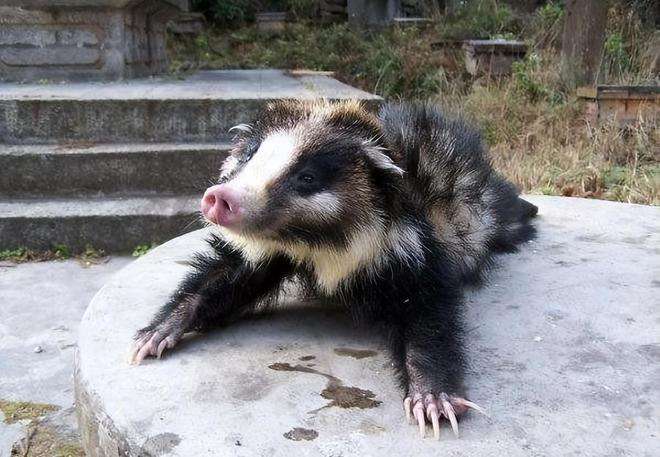Arctonyx collaris
IUCN
LCBasic Information
Scientific classification
- name:Arctonyx collaris
- Scientific Name:Arctonyx collaris,Hog-Badger,Sand badger, mountain badger
- Outline:Carnivora
- Family:Schizopoda Mustelidae Badgerinae Hog
Vital signs
- length:55-75cm
- Weight:6.5-7.5kg, up to 15kg
- lifetime:10-14years
Feature
The body is stout, with a bare and protruding snout like a pig's snout.
Distribution and Habitat
Distributed in Bhutan, Cambodia, China, India (Assam), Indonesia (tribute to China), Lao People's Democratic Republic, Mongolia, Myanmar, Thailand, Vietnam.
It is found in all provinces and regions in China, especially in the south.
The wild hog badger lives in broad-leaved forests, mixed coniferous and broad-leaved forests, shrubs, plains, hills and other environments in high, medium and low mountainous areas. [1] It generally chooses natural rock cracks and tree holes as its habitat.
Appearance
The hog badger is stout and has short limbs. The snout is exposed and protruding like a pig's snout, hence the name. The head is large and the neck is thick, with small ears and eyes. The tail is short, usually no longer than 200mm. There are 5 fingers (toes) on the front and back limbs, and the claws are well developed.
The whole body of the hog badger is a mixture of black and white. There is a white stripe in the middle of the head from the exposed snout to the back of the neck, which is about the same width as or slightly larger than the snout width; the hair in the front is white and obvious, and gradually black-brown hair is mixed in from the back to the neck, showing white and mottled, and extending to the shoulders on both sides behind the ear shell. There is a wide black-brown band from the sides of the snout to the ear shell and through the eyes, which gradually widens backwards, but there is a clear white area under the eyes, and the black-brown band behind it gradua
Details
Hog Badger (scientific name: Arctonyx collaris) is also known as Hog-Badger in English. There are 6 subspecies.

Hog Badger likes to live in caves, digging caves in barren hills, roadsides, ridges, etc., and also invading the caves of other animals. The structure of the cave is relatively simple, with 1 to 2 entrances, mostly located on steep sunny slopes or where there is dense grass. The cave is often a straight cave 1 meter deep, and there are also straight caves as long as 8 to 9 meters. The whole cave appears clean and dry. The sleeping place is often covered with hay.
The hog badger is nocturnal. It has a fierce temperament. When attacked by an enemy, it often lowers its front legs and makes a ferocious roar, which sounds like a pig. At the same time, it can stand up and fight back fiercely with teeth and claws. It can swim in the water. It has poor vision, but a keen sense of smell. When looking for food, it often raises its head to smell with its nose, or digs the soil with its nose.
The hog badger has the habit of hibernation. It usually starts hibernation in late October. Before hibernation, it eats a lot to increase body fat. After hibernation, they sometimes come out of the cave to bask in the sun when the temperature is high at noon. They start to move out of the cave in March of the following year.
Hog badgers are omnivorous. They mainly feed on earthworms, frogs, lizards, loaches, eels, crustaceans, insects, centipedes, birds, rodents and other animals, and also eat crops such as corn, wheat, potatoes, and peanuts.
The distribution of the population of hog badgers is not scattered. Hog badgers are common in the Lao People's Democratic Republic, Thailand, the high mountainous areas of Sumatra, Indonesia, and the southwest and eastern regions of Cambodia. In Myanmar, due to the decrease in witnesses, it can be said that the abundance of this species has generally decreased. Studies have shown that the population trend of hog badgers may be different in its distribution range, but the overall population is on a downward trend.
The main threat to the wild hog badger is hunting. Trade-driven hunting in Vietnam and Laos has caused a rapid decline in the wild hog badger population. The indirect threat to the wild hog badger population caused by human development has yet to be proven. Because the density of the species is also low in the large forests in the east of its distribution range, this suggests that the main threat there is still hunting. In Kaziranga National Park in India, periodic flooding may cause the death of some wild hog badgers, or the increasing fragmentation of natural habitats may lead to higher mortality, but these may be insignificant to the overall decline rate of the species and are only potential local threats. In Europe, wild hog badger hair can be used to make shaving brushes, but it is not clear whether it comes from the wild population of the species. It is more likely to come from large farmed populations in China.
Listed in the "National List of Terrestrial Wildlife with Important Economic and Scientific Research Value" issued by the State Forestry Administration of China on August 1, 2000.
The Hog Badger is listed as a key protected animal by Jiangsu Province, China.
Listed in the 2008 Red List of Endangered Species of the World Conservation Union (IUCN) ver 3.1 - Near Threatened (NT).
Protect wildlife and eliminate game.
Maintaining ecological balance is everyone's responsibility!








